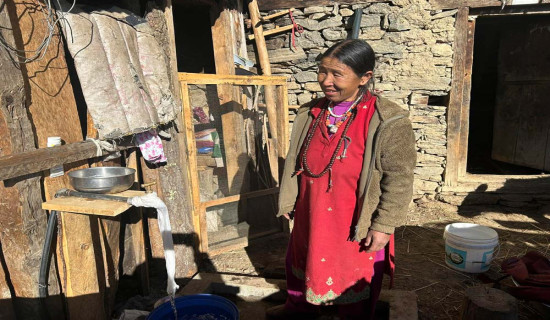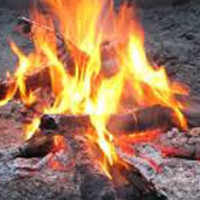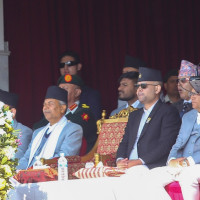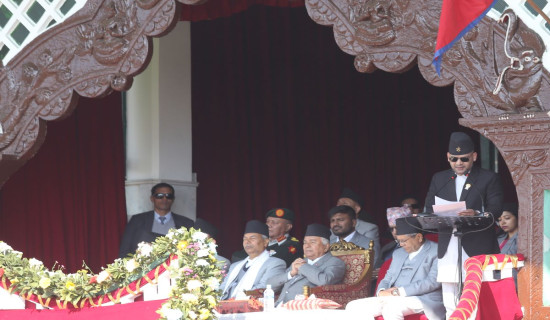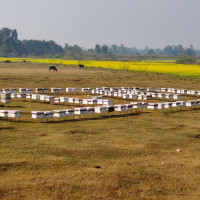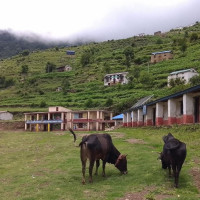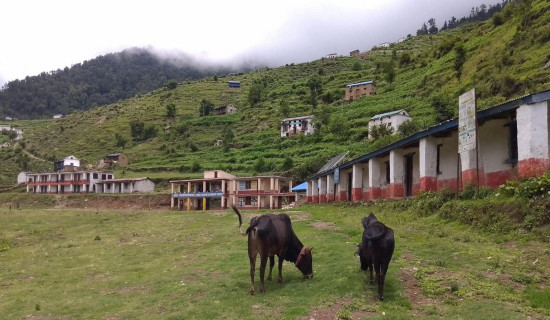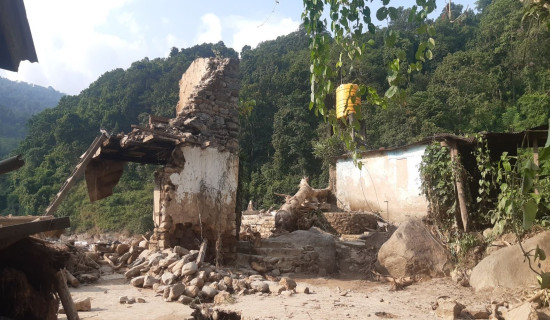- Monday, 15 December 2025
Traditional Asare Geet losing ground to commercial songs
By Santosh Subedi,Kaski, June 26: Traditional Asare Geet, sung while planting rice in the fields during the Nepali month of Asar, has been fading in recent years.
Covered in mud, the ‘Bause’ (ploughman) and ‘Ropar’ (planters) used to throw mud at each other while singing songs that helped them forget their exhaustion and hardship.
The sound of water flowing from streams, rivers, and irrigation canals added melody to the Asare Bhaka, making the atmosphere more joyful. These songs made the laborious work lighter and more enjoyable.
In the past, Asare Geet could be heard as soon as Ashar began, but now, their singing has faded.
Singer Haridevi Koirala said, “In an agriculture-based country, Asare Geet should be preserved. If these original, culture-based songs are protected and promoted, it will be easier for the new generation to understand them.”
She also adds that the media no longer play Asare Geet, and that these cultural songs should be approached through research and preservation. She said these songs, which change with time and season, are a significant part of Nepali culture.
Koirala said that the new generation doesn't even know how to sing Asare Geet. Previously, planting rice, removing uprooting rice saplings, and enjoying together made the Asare season like a festival.
But now, the excitement around Asare paddy plantation has diminished. “In the old days, people would eat early in the morning, go to the fields as if attending a fair, play with the mud, and work until evening. But now it has become more of a fashion and the tradition is disappearing,” she said.
Koirala observed that with the decline of Asare Geet during plantation, the tukka (short rhyming verses) that accompany them are also vanishing.
Older recordings are not available due to technological limitations, and new artists are prioritizing commercial songs over cultural ones. As a result, preserving these traditional songs has become more challenging.
How are they sung?
The Asare Bhaka also reflects Nepal’s geographic diversity. In the eastern region, it is called Rasiya, while in the western region, it is known as Kanthe Bhaka.
The singing begins by stretching the legro (first musical line), followed by rhyming tukka, and concludes with closing line. These verses typically contain 16 syllables, with a rest at 10 syllables, and are sung with long, melodic tones.
Former president of the Rastriya Lok Tatha Dohori Geet Pratisthan Nepal, Purushottam Neupane, said that because Asare Geet are only played for a month, they are not recorded often for commercial purposes. “People who fund recordings can’t get their investment back within a month, so they don’t want to take the risk. These are seasonal songs, and they need to be preserved,” he said.
He added that for farmers, Asar is the real festival. They work for a month to feed themselves for the whole year, so they also want to enjoy the moment. That’s why there is a tradition of making songs about seeds, ploughmen, and planters to sing and complete the work with joy. “There aren’t many Asare Geet. A few old ones remain, but today’s generation can’t afford to spend Rs. 150,000–200,000 just for songs to be played only in the month of Ashar,” Neupane added.
Popular Asare Geet
‘Hariyo Danda Mathi Halo Jotne Sathi’ by the late Dharma Raj Thapa beautifully captures the essence of Ashar. When this song is played, it brings out the real feeling of the season. It was later re-recorded in the voice of Ramchandra Kafle.
‘Rimi Ra Jhimi Pani Hai Paryo Asarai Mainama, Hideko Haami Dhan Ropna Benshiko Pataima’ is another popular Asare Geet in the eastern style, sung by Nabin Kumar Khadka, Hari Bahadur Khatri, Kamal Bahadur Khatri, and Pustak Khadka.
‘Rato Ma Rato Asare Phulyo Ban Ra Pakhama, Jhukiri Nani Gauna Thalin Surilo Bhakama’ is written by Tirtha Raj Adhikari sung by Padma Raj Dhakal and Sabitri Shahi.
‘Chhupu Ma Chhupu’ by Narayan Rayamajhi is also one of the songs frequently heard during Ashar.



